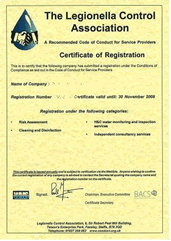
Legionella Risk Assessments
The foundation of our services portfolio is the Risk Assessment, which is the first essential step in reducing risk at your premises. This in-depth, system assessment addresses each site for the likelihood of legionella growth, and the level of exposure to the organism. Water systems that harbour such substances and which are likely to proliferate can be found in all types of premises, ranging from retail outlets to hospitals. Mains-fed systems provide no assurances that the premises is risk-free!
Those individuals that are susceptible to such pathogenic organisms will also increase the level of risk. This includes the elderly, those that are immune-suppressed - for example hospitals - and those who smoke.
According to the Approved Code of Practice (ACoP) for the Control of Legionella Bacteria in Water Systems (L8 2001), a risk assessment must be carried out by a competent individual on those premises where water is stored or transmitted, and where a spray is generated by what-ever mechanical means. The output of this assessment provides a comprehensive set of findings with an action plan with clear itemisation of the priorities. Ordered according to the risk rating and the resources required to negate those risks, the associated remedial work and on-going monitoring and control program is meticulously structured. See Written Scheme.
Risk Assessment Review
Note that a Review must be carried out at least every 2 years or sooner if the risks that have been identified could, in any way, be influenced by significant changes. This includes changes to the water system or its use; changes to the use of the building in which the water system is installed; the availability of new information about risks or control measures; the results of checks indicating that control measures are no longer effective; a case of Legionnaires’ Disease / Legionellosis is associated with the system
The Cost of Non-compliance
Though the L8 ACoP is not regulatory in its own right, failing to meet the above requirements can lead to prosecution. The Health and Safety Work Act 1974 or The Management of Health and Safety at Work Act 1999 that is more specific to carrying out risk assessments, can be applied in court to administer a hefty fine if not possible criminal charges for gross negligence. Such outcomes are no better demonstrated than in the Barrow in Furness incident of August 2002.
For more information including the key failure areas, refer to the link http://www.hse.gov.uk/legionnaires/barrowreport.pdf - a report published by the HSE. Subsequent to the report, the Design Services Manager was cleared of manslaughter charges on 31 July 2006.
However both she and her employer, Barrow Borough Council, were found guilty under section 7 of the Health and Safety at Work Act 1974. The council was fined £125,000 and ordered to pay costs of £90,000. The Services manager was fined £15,000
Maintaining Competency at Life Environmental – Registration with the Legionella Control Association
 At Life, we adopt a robust policy of maintaining competency at the highest level through regular auditing and inspections of those sites that our surveyors have already assessed. The same policy is also encapsulated in at least one of nine Codes of Conduct for Service Providers who offer services in Legionella Risk Management.
At Life, we adopt a robust policy of maintaining competency at the highest level through regular auditing and inspections of those sites that our surveyors have already assessed. The same policy is also encapsulated in at least one of nine Codes of Conduct for Service Providers who offer services in Legionella Risk Management.
The Codes have been developed jointly by the Water Management Society (WMSOC) and British Association of Chemical Specialities (BACS), and regulated by the Legionella Control Association. (LCA). A condition of membership through registration is that all Service Providers internal quality systems are independently assessed by the LCA, not least the effectiveness of the policy and procedures put in place on customers sites.
For more information please contact our Water Hygiene Department on 0113 271853